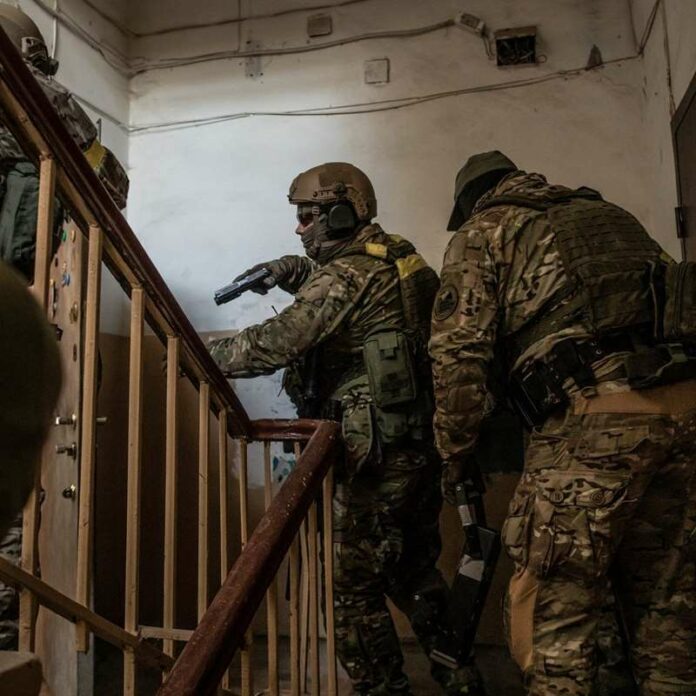Ukraine is now persecuting the Orthodox Church, its clergy and its members as it conducts extensive searches in dioceses church’s and church properties including monasteries in moves reminiscent of Hitler’s Nazi attacks on the Jews. In an attempt to give legality to religious repression Ukraine’s National Security Council has imposed sanctions against members of the Ukrainian Orthodox Church which adheres to the Moscow Patriarchate. This followed a meeting concerning the activities of religious organizations, resulting in searches in diocesan property, including churches and monasteries across the state. Those sanctioned included Pavlo Lebed, governor of the Kiev Caves Monastery, which was declared a world heritage site by the United Nations Educational, Scientific and Cultural Organization (UNESCO). Also sanctioned was former deputy of the Ukrainian Parliament, Vadim Novinski, according to a UNIAN news agency report.
Churches Branded as Terrorist Centres
Zelenski’s National Security Council told the government to submit a bill to parliament banning the activities of all religious organizations with alleged Russian ties. Ukraine’s president, Zelenski signed a decree validating this decision. The Ukrainian government now has two months to justify this in Parliament with sufficient “legal grounds” under international law according to a report from the Ukrinform news agency. Meanwhile searches in Orthodox Churches continued on Friday in Yitomir, Rivne and Transcarpathia. In an attempt to justify this repression Ukraine’s Security Service, the SBU claimed that these searches were carried out to “protect the population from provocations and terrorist acts”.
Subversive Prayer Texts
According to the SBU’s Telegram profile, those searches found “prayer texts” of Patriarch Kirill, head of the Orthodox Church in Russia, as well as some cash. The SBU also claim that they found Nazi symbols and propaganda leaflets calling to join the Russian Army. The SBU also reported that the Metropolitan Archbishop of Kirovohrad diocese is suspected of organizing “subversive activities against Ukraine“. The SBU further claimed that “The bishop was part of Kirill’s inner circle, with whom he coordinated the spread of pro-Kremlin views in the region.” On November 25th searches were carried out in several monasteries throughout the country including the capital Kiev. The SBU reported that, following searches of the buildings, they found “religious manuals from Moscow, documents in Russian and “pro-Kremlin” literature.”
Church Subversion Claims
Ukraine has continuously been carrying out those searches of what they call religious organizations (meaning the Orthodox Church) for many weeks, claiming that all these searches are to ensure national security and because they claim that the Orthodox Church has been spreading Russian propaganda and promotes recruitment for the Russian army, among other “subversive” activities.
The Orthodox Church’s Kievian Origins
The Russian Orthodox Church traces its origin back more than a thousand years to Kiev in AD 988, when Byzantine missionaries from Constantinople baptised Vladimir the pagan prince of Kiev, his family and Kiev’s inhabitants. For the next seven centuries, Kiev remained the centre of the Russian Orthodox church until Tsar Peter the Great in the 17th century moved its seat to Moscow. The Orthodox patriarchate in Moscow included and continues to include millions of Orthodox Ukrainians in their fold. It also commands respect from most of the world’s 15 independent Orthodox churches.
Politics and Religion
The Russian Orthodox Church consists of 100 million of the world’s 260 million Orthodox Christians. While all other Christian churches are in steep decline the Russian Orthodox Church is the rapidest growing Christian Church in the world. In January 2019 the Patriarch of Constantinople Bartholomew I acting in what can only be described as a nefarious unilateral political move acting in his role as ‘first among equals’ among the Orthodox patriarchates, recognised the merger of two Ukrainian churches in their politically inspired break from Moscow as ‘the independent Orthodox Church of Ukraine’. In retaliation Patriarch Kirill in Moscow broke all ties with Bartholomew 1 of Constantinople and branded the breakaway Ukrainians as heretics. The breakaway church now calls itself the Ukrainian Orthodox Church.
Justification for Persecution
Despite Bartholomew I’s sanctioned break a large number of Orthodox Christians in Ukraine continue to remain loyal to Moscow. They and their church are now being persecuted by Kiev’s secret police the SBU who regard them as children of a subversive god. Those in Ukraine remaining loyal to the Russian Orthodox Church are regarded by the Kiev regime as Russian fifth columnists. Since Kiev’s military attack on the Russian speaking Donbas region in 2014 (the real start of the war) the local clergy naturally sided with their faithful, the Russian speaking people of Donbas. Since then the American Coup created regime in Kiev have regarded and treated them as enemies. Kiev’s present moves are merely a ramped up continuation of that policy.
Share this article with your family and friends
irishpeople.ie

